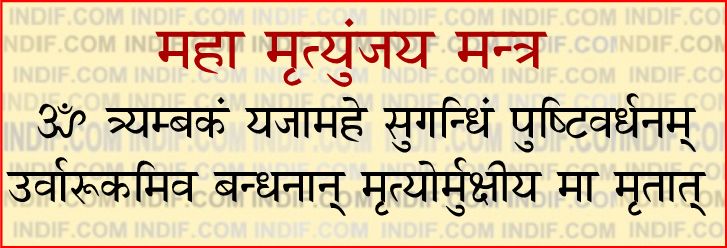There is a Sakti or power in every word. The Name of God, chanted correctly or incorrectly, knowingly or unknowingly, carefully, is sure to give the desired result.The glory of the Name of God cannot be established through reasoning and intellect. It can be experienced or realized only through devotion, faith and constant repetition of the Name. By Mantra japa, you can attain peace of mind quickly. By prolonged and constant practice the inherent power of the Mantra (Mantra-Sakti) will be awakened, which will fill your very existence with the Divinity of the Mantra.
MANTRAS FOR JAPA
Lord Ganapati:
Om Sri Ganapataye Namah
Lord Shiva:
Om Namah Shivaya (Panchakshara)
Maha-Mrityunjaya Mantra:
Om tryambakam yajamahe
sugandhim pushtivardhanam
uurvarukamiva bandhanaan
mrityor mukshiya maamritaat.
Sri Devi:
Om Sri Durgayai Namah
Sri Kalika:
Om Sri Kalikayai Namah
Sri Lakshmi:
Om Sri Maha-Lakshmyai Namah
Lord Hari:
Om Namo Narayanaya (Ashtakshara)
Hari Om
Hari Om Tat Sat
Lord Krishna:
Maha-Mantra :
Hare Rama Hare Rama
Rama Rama Hare Hare
Hare Krishna Hare Krishna
Krishna Krishna Hare Hare
Om Namo Bhagavate Vasudevaya
Om Sri Krishnaya Govindaya Gopijana Vallabhaya Namah
Om Sri Krishnaya Namah
Sri Hanuman:
Om Sri Hanumate Namah
Lord Rama:
Om Sri Ram Jaya Ram Jaya Jaya Ram
Om Sri Ramaya Namah
Sri Rama Rama Rameti,
Rame Rame Manorame
Sahasranama Tattulyam Rama Nama Varanane
Om Sri Sita-Ramachandradhyam Namah
Sri Ram
Sri Saraswathi:
Om Sri Sarasvatyai Namah
Lord Subramanya, Kartikeya:
Om Sri Saravanabhavaya Namah
Sharangati Mantra (for surrender):
Om Sri Ramah Sharanam Mama
Om Sri Krishnah Sharanam Mama
Om Sri Sita-Ramah Sharanam Mama
Sharada:
Om Sri Bala-Parameshvaryai Namah
Tripurasundari:
Om Sri Tripura-Sundaryai Namah
Vedantic Formulae:
Om Soham
Om Tat Tvam Asi
Om Aham Brahma Asmi
PRACTICAL AIDS TO JAPA
1. Select any Mantra or Name of God, preferably that given to you by your Guru, and repeat it from 108 to 1,080 times daily (one to ten malas).
2. Always keep your Guru-Mantra a secret. Never disclose it to anyone. It is better to stick to one Mantra only. Take a bath or wash your hands, feet, face and mouth before sitting for Japa in the morning. At other times this is not absolutely necessary. Do Japa whenever you have leisure, at the three junctions of the day - morning, noon and evening - and before going to bed.
3 The early morning period (Brahmamuhurta) and dusk is the most favourable time for Japa and meditation. This is when Sattva (purity or steadiness) is predominant.
4. Face east or north during the practice. This enhances the efficacy of the Japa.
5. Sit on a deer skin or rug. Spread a piece of cloth over it. This conserves body-electricity. Sit in a separate meditation room or in any suitable place, such as a temple, on a river bank or under a banyan or peepul tree.
6. Maintain a steady pose. Attain mastery of the posture. You must be able to sit in Padmasana, Siddhasana or Sukhasana for three hours at a strech. Recite some prayers before starting the Japa. Reslove to complete a certain minimum number of malas before leaving your seat.
7. A rosary is a whip to goad the mind towards God. Use a rudraksha or tulsi mala of 108 beads. Do not allow the mala to hang below the navel. Keep the hand near the heart or the nose. The mala must not be visible to you or to others. Cover it with a towel or handkerchief, which must be clean and washed daily. Use the middle finger and the thumb of the right to roll the beads. The use of the index finger is prohibited.Do not cross the meru while rolling the beads. Turn back when you come to it.
8. Do mental Japa for sometimes without a mala. When the mind wanders, do the Japa aloud, or whisper the Mantra for some time and come back to mental Japa again as soon as possible.
9. When you repeat the Mantra, have the feeling or mental attitude that the Lord is seated in your heart, that purity or Sattva is flowing from the Lord into your mind, that the Mantra is purifying your heart, destroying desires, cravings and evil thoughts.
10. Do not do the Japa in a hurried manner. Do it slowly with feeling, one-pointedness of mind and single-minded devotion. Pronounce the Mantra distinctly and without any mistakes. Repeat it neither too slowly nor too fast. Increase the speed only when the mind wanders. Be vigilant and alert during Japa. Stand up when sleep tries to overpower you.
11. Try to associate the Japa with the rhythm of the breath and meditate in the form of your Deity. Keep a picture or idol of the Deity in front of you. Think of the meaning of the Mantra while repeating it. Regularity in Japa Sadhana is most essential if success is to be achieved. Sit in the same place and at the same time every day. Do not beg for any worldly objects from God while doing Japa. Feel that your heart is being purified and that the mind is becoming steady by the power of the Mantra and the Grace of the Lord.
12. Observe silence and avoid distractions, calls and engagements. It is important not to leave the place at once after the Japa is over and mix with everyone or plunge into worldly activity. Sit very quietly for at least ten minutes, humming some prayer, remembering the Lord and reflecting upon His infinite love. Then, after devout prostration, leave the place and commence your routine duties and activities. In this way the spiritual vibrations will remain intact. Continue the current of Japa mentally at all times, whatever be the activity in which you are engaged. Carry on your Sadhana with tenacity and perseverance, without a break. Realize the glorious goal of life and enjoy supreme bliss













